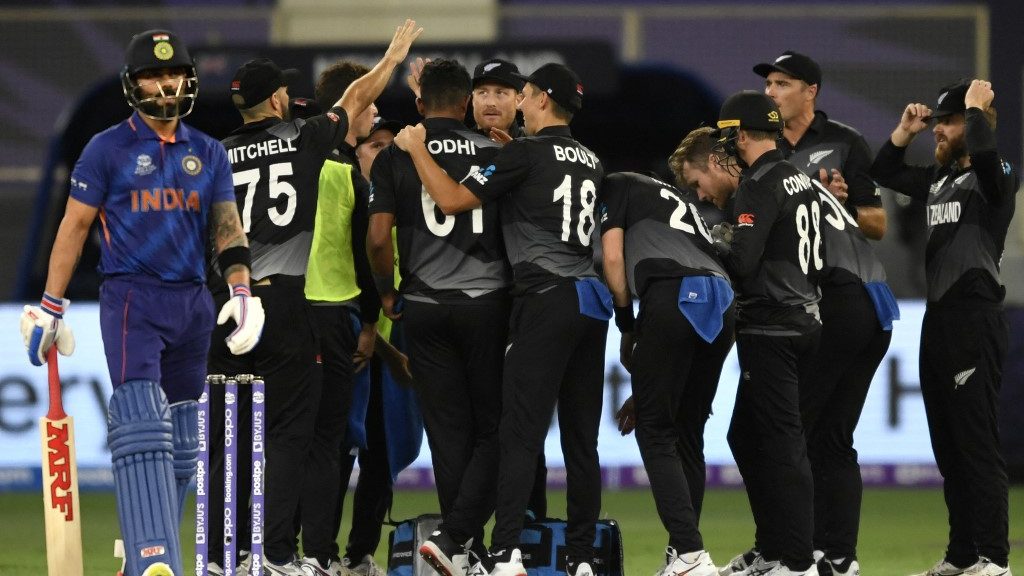T20 WC 2021: IND vs NZ – The batting order that led to chaos

“Will you drop Rohit Sharma from T20 internationals? You will drop Rohit Sharma? Do you know what he did in the last game that we played?”
Indian captain Virat Kohli’s above response went viral within hours of India’s defeat to Pakistan in their opening clash of the T20 World Cup 2021. A journalist had asked whether Ishan Kishan should have been preferred ahead of Rohit Sharma as an opener. One week later, the journalist’s wish came true partially.
…
India made two changes to their playing XI ahead of the all-important clash against New Zealand. Ishan Kishan replaced injured Suryakumar Yadav whereas Shardul Thakur was added in place of hapless Bhuvneshwar Kumar. At the toss, Kohli confirmed that Kishan will be opening the innings. His opening partner was assumed to be Rohit Sharma. However, it was KL Rahul who stepped out with Kishan to commence the innings.
Kishan opening the innings solved India’s many issues in one go. It added a left-hand batsman to India’s otherwise right-hand loaded top order. It allowed a left-hander to confront Trent Boult’s left-arm angle which has proven to be India’s pain point in recent years. It also ensured that Kishan batted in a batting position that is best suited him. The youngster did face eight out of 12 deliveries bowled by Boult in the powerplay but was on his way back on the eighth delivery.
In walked Rohit Sharma. This was only the third time in T20I cricket that he was batting at number three (the previous two instances being in the years 2011 and 2020). Despite Kishan’s shielding, Rohit had to face one ball from his Mumbai Indians spearhead bowler. It nearly ended in a first-ball dismissal as Adam Milne shelled a straightforward catch. Other than the two boundaries that he scored off Milne’s over, Rohit looked a pale shadow himself. He eventually holed out to the leg-spinner, Ish Sodhi after a labouring knock of 14 (14).
Ish Sodhi named Player of the Match with vital wickets in the middle overs in Dubai. Sodhi finished with 2-17 from his four overs with the wickets of Rohit Sharma and Virat Kohli. #T20WorldCup pic.twitter.com/TFEwxaWXcL
— BLACKCAPS (@BLACKCAPS) October 31, 2021
By the time Kohli arrived at the crease, India had played out 5.5 overs. The Indian captain could face only one ball in the powerplay. It is no secret that the run-machine is at its slowest in the middle overs. In the last two years of T20I cricket, Kohli’s strike rate in overs from 7 to 11 is 105.7, bel0w-par by any standard. It is also no secret that the bowling type against which he struggles the most is leg spin. With New Zealand having Ish Sodhi in their ranks, Kohli’s two major adversaries joined hands. Sodhi snared him as Kohli returned with a disappointing score of 9 runs off 17 balls.
…
The top four that India fielded, Ishan Kishan, KL Rahul, Rohit Sharma and Virat Kohli have all batted in various positions throughout their career. And this is not to say that any of them is incapable of batting outside of their usual batting spot. However, the essence of a neat batting order lies in optimising the strengths of their batsmen and covering up their weaknesses. India faltered in both aspects.
While promoting Kishan at the top was a positive move, demoting Rohit sent out wrong signals. It also robbed the right-hander of the powerplay cushion which he is otherwise used to. This move also ended up in consigning Kohli to number four which resulted in him having to accelerate in the middle overs against a leg-spinner. India could have avoided all this by shifting KL Rahul to number four, a position not alien to him.
India have now used three different opening combinations in their last three T20I encounters. The opening partnership is the keystone of a T20I innings. It has proven to be even more important in the UAE conditions where the first six overs have been the easiest to bat in. India’s muddled approach at the top has hampered their chances already, hopefully the Men in Blue will find their stride in the remaining games.
